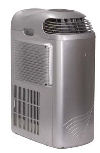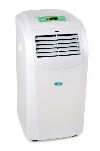How Does Portable Air Conditioning Work?
How Does Portable Air Conditioning Work?
The 1st item on the agenda is how much cooling do you need to “Defeat the Heat”, the 2nd item is “how” are you going to eject the heat and replace it with cooling.
Unfortunately, there is no cooling equivalent to a heater, where you just plug it in and it gives out Cold air. Once your environment is hot, to cool it down you have to eject the heat to the outside and hence explains why no one has successfully invented air conditioning to be fitted in the underground tube trains (inspite of a reward offered). In this therefore (for you) hangs the most major question in “the how”.
The “how much” cooling and the “how” to do it, is a chicken and egg situation. However, It is easier to start by calculating the cooling required, and by that you need to work out how much heating is being produced, (for this there is a easy to use calculator)
You need this because if you can imagine a tank of water, where the level of the water is the temperature in your office, if you have 10 gallons of heat coming in, you need 11 gallons of cooling draining out to make the level come down. Unlike heating, you cannot cool a little bit, hence if you have 10 gallons of heat coming in and 9.5 gallons of cooling draining out, the level will still keep rising albeit slowly.
So you have to Defeat the Heat entirely to achieve cooling.
We know this takes some understanding, as this is an area of confusion most commonly asked. You can of course have what they call “spot cooling”, which means that (like pouring cold water at one end of a bath) the only person sitting next to the unit gets cool.
The units of measurement in cooling is Btu’s (British Thermal Units) or in Kw (Kilowatts) – its roughly 3,500 Btu’s = 1 Kw.
On average in an office one person requires 4,000 Btu’s of cooling, hence a standard office with 2 people would require an 8,000 Btu machine.
If you know the capacity you now need to understand how to eject the heat, you must understand the three methods of cooling.
Normal Office / shop / Restaurant Fixed Installed systems (not portable are also called “Split units”), where the out door bit (a condenser fan) is mounted to an outside wall or placed on a flat roof, is connected to the inside bit (the evaporator fan) mounted in the ceiling or on a wall, by copper pipes and some electrical wiring and a water pipe (a side effect of cooling is that it takes water out of the air), and some builders work to make holes in the wall. This is probably the best method, but is expensive to install and maintain, hard to get authorised by landlords and the local council and with the new gas regulations, expensive to move or remove, in most cases you will have to jump through lots of hoops. You need plenty of time as well as it can take from one month to 12 months (and sometimes more) and when it fails can take 2 weeks or so, to get fixed.
You then come to the main range of quick fix portables, which over the last few years have improved considerably. There are three main types, (each with sub divisions), Hose type, Split type and Evaporative coolers. These can be used as permanent solution or temporary when the main fixed air conditioning has failed and you need that quick fix.
Portable Hose type:- This is about 90% of the market and is by far the most popular. Hose types come in two distinct sub groups, those with water bottles or a drainable tank (often called monoblock), and those without called Air-to-Air machines. As mentioned before, a side effect of cooling is that it takes water out of the air, (rarely a problem in England because the humidity is so high in the summer). This water needs to be removed.
Hose units that have water bottles are usually cheaper and mainly used domestically, this is where the owners do not mind emptying the bottle, or drain a tank etc. every day. Whilst, in business, to get someone to empty 10 – 100 bottles every day, just does not happen, especially in server rooms left unattended at weekends.
The Air-to-Air units remove the water by re-humidifying the dry hot air being ejected to outside, hence allowing the unit to run 24/7 unattended and is the choice of most people when they know that there is this difference, especially, for facilities managers, when they order the wrong type.
You can see the same effect on any domestic fridge at home. The cooling effect inside the fridge produces water or condensation in the freezer box it turns to ice but in the main fridge by good design, this water runs down to a small hole at the bottom at the back of the fridge, where it drips through to the outside and onto a small tray fixed to the top of the hot compressor, which in turn with its heat, re-evaporats the water.
The hose must go to another area, into a vented false ceiling, out of the window, into the corridor etc. The Standard length of a hose supplied with the unit is about 1 meter, so quite often extensions are fitted (an extra 2 meters). In an emergency for 1-2 days we will extend this further, leaving a window partially open can cause noise and security problems, window fixing kits and through the wall fixing kits are becoming more popular as they do not generally require any form of approval.
There are places where you will not get planning permission or get access to the back of the building or you are on the 20th floor of a 30 story building, where you just cannot hang anything out of the window, so hose types (where everything is internal) is your only choice.
Rarely, some people report, they have no windows or that that their windows are sealed closed, no ventilation and cannot leave the doors open. Well in this case under normal circumstances they need not worry too much about cooling, as they will suffocate before we can get to them, but in any case is against the H&S at work act.
Sometimes we receive similar reports when existing air conditioning fails, but what usually they do not know, is that the air extract air system is independent, so we can connect our hoses to their extract system.
Portable Split Type:- These are not to be confused with Fixed Split types, although they do the same job. Portable Splits are self contained units, with semi flexible pipe of a fixed length (3-4meters usually, although there are specialised units that are longer eg 30 meters) between the indoor unit and the outdoor units and they plug into a standard 3 pin plug. The outdoor unit (about the size of a brief case) is usually hung out of a window on safety chains, but because of the small diameter of the inter-connecting pipe work, this is often drilled through the window frame or a hole in the wall, again to keep the windows shut.
Years ago, councils used to complain, about hanging the outdoor unit outside, as they would confuse it with a fixed system type box. Not any more as they now recognise this difference and the time they give you to rectify this apparent misdemenour the end of the summer comes all to quickly, besides that, they are overwhelmed by too many units anyway.
Portable Evaporative Type:- Rarely used, these do not require an outdoor bit, you must bring the outdoor air literally to the Evaporative Cooler. These units make use of the principle that if you evaporate water you get a cooling effect. Much like blowing water off of the back of your hand, it feels cold.
However, and I mean however, this is achieved by putting copious amounts of water into the air. Hence, they do not work well in high humidity or at all in a closed environment.
You must never use them in server rooms (it will become a sauna), but they do work reasonably in warehouses, shops with open doors or anywhere where there are a goodly amount of fresh air via open windows ect.
They also work well where you have existing air conditioning, as additional cooling, remembering that whilst they are busy putting water into the air, the existing air conditioning units are busily taking it out (a win / win situation).
At best they only give a couple of degC drop, whilst Hose and Splits (proper cooling) give 10- 20degC drop. Because the cooling capacity depends on humidity, the manufactures rate these in “recommended area” covered, usually in square Meters ie 15, 20, 30 and 60 sq. Meters is usually normal. The 15’s for small domestic use, 20’s & 30’s for offices, and the 60’s for warehouses.
Crunch Time:- On the basis that you know what you need, mostly likely (90%) you need hose types, for example 22,000 btu’s of cooling, you can choose from 3 x 8,000btu machines, 2 x 12,000btu or 1 x 8,000btu and 1 x 15,000btu, a decision you must make depending on the layout of your space, heat emmiting equipment and access to the outside.
In your own home it is a lot easier as usually you just back one (suitably sized) unit up to one window, stick the hose out and away you go.
Hoses usually come with a fish tail (like a hoover nozzel), so you can shut the window to about 2 inches and block any remaining air gap with some paper or foam (if you want to) then later once you decide on a good location for your portable install a perminant fixing kit.
Hiring for companies in commercial premises is becoming very popular, more because of the services offered, in the event one should fail, commonly this is called “swap-in / swap-out” and of course the flexibility to add, upgrade – try out etc. etc. With no winter storage and ongoing maintenance charges, its 100% claimable against tax & vat the accountants love it.
However, a lot of hire companies do not hire where cooking is carried out on the premises, as they cannot get the smell out of them afterwards (which includes your home). Its a good question to ask your hire firm, “do you hire to restaurants” because if they do, you could get a smelly one!
I bet at this point – you wish you never asked, but on the basis that the one eyed man is King in the land of the blind, next time someone asks – you have the condensed version of the Bluffers Guide to Air conditioning, use wisely and you could rule the planet.
John Brassington
Chilly Pepper Hire








Leave a Comments
You must be logged in to post a comment.